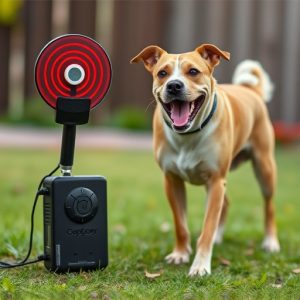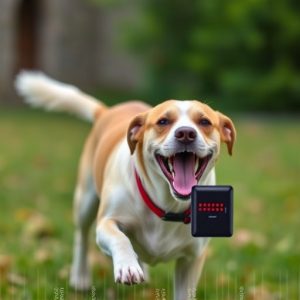Electronic Dog Repeller: Effective Frequency Range & Safety Certifications
Electronic dog repellents have evolved, using specific frequencies to deter canines without harm. Su…….
Electronic dog repellents have evolved, using specific frequencies to deter canines without harm. Success hinges on targeted frequency ranges, with safety a paramount concern. Certified products adhere to strict Electronic Dog Repellent Safety Standards, guaranteeing harmless operation for pets and humans. Choosing a safe repellent involves understanding frequency tailoring, adjustable settings, certifications from reputable bodies, and durable designs suitable for outdoor use. Ethical considerations demand rigorous testing for safe operation, ensuring pet well-being while addressing unwanted canine behavior.
Introducing our comprehensive guide on electronic dog repellents, designed to help you navigate this effective deterrent option. Understanding how these devices work is key, especially the role of frequency range in their efficacy. This article delves into the technology behind dog repellers, highlighting the significance of specific frequencies in deterring canine intruders. We explore safety standards and certifications, crucial for responsible use, and provide a buyer’s guide to selecting the ideal repeller. Learn about ethical considerations and discover what owners need to know when utilizing this innovative solution.
- Understanding Dog Repeller Technology: How It Works
- The Importance of Frequency Range in Dog Deterrents
- Electronic Dog Repellent Safety Standards and Certifications
- Choosing the Right Repeller: Factors to Consider
- Effectiveness and Ethical Considerations: What Owners Need to Know
Understanding Dog Repeller Technology: How It Works
Dog repeller technology has advanced significantly, utilizing specific frequencies to deter canine intruders. These electronic dog repellent devices operate on the principle of emitting sounds or signals that dogs find unpleasant, encouraging them to stay away from treated areas. The effectiveness lies in the precise frequency range targeted, which varies among products. Repellers are designed with safety in mind, adhering to strict Electronic Dog Repellent Safety Standards and Certification guidelines to ensure they pose no harm to pets or humans.
The technology often involves emitting ultrasonic sounds beyond human hearing thresholds but within the sensitive auditory range of dogs. Other methods use specific scents or vibrations that trigger a dog’s natural aversion responses. Repeller manufacturers meticulously test their products to guarantee they meet certification criteria, ensuring both safety and efficacy in repelling dogs without causing them harm.
The Importance of Frequency Range in Dog Deterrents
The effectiveness of a dog repeller largely hinges on its frequency range, which determines how well it can deter canine intrusions. Different dogs have varying sensitivity to sounds, and electronic dog repellents utilize specific frequencies to trigger an unpleasant reaction in them. A wide frequency range ensures that the device is effective against a broader spectrum of dogs, from small breeds to larger ones, making it a more versatile choice for various settings.
When selecting a dog repeller, it’s essential to consider products certified under Electronic Dog Repellent Safety Standards. These certifications ensure that the devices operate within safe sound pressure levels and are designed with user safety in mind. This is crucial as using repellents with excessive or poorly targeted frequencies could potentially harm both pets and humans, which is why adhering to industry standards is vital for responsible pet management.
Electronic Dog Repellent Safety Standards and Certifications
When considering an electronic dog repellent, it’s crucial to look for products that adhere to stringent safety standards and certifications. These ensure that the device is not only effective in deterring dogs but also safe for both humans and pets. Repellents should be designed with safety features like automatic shutdown mechanisms, waterproof designs, and low-frequency emissions below 30 kHz to avoid harm or discomfort.
Reputable manufacturers often seek certification from recognized organizations to validate their products’ safety and performance. Look out for certifications such as CE (Compliance with European Safety Standards), UL (Underwriters Laboratories), or similar marks indicating that the electronic dog repellent has met rigorous testing requirements, minimizing potential risks and ensuring a secure user experience.
Choosing the Right Repeller: Factors to Consider
Choosing the right electronic dog repeller involves considering several factors to ensure its effectiveness and safety. One crucial aspect is understanding the frequency range it operates on. Different dogs have varying sensitivities to sounds, so a device that produces frequencies tailored to deter specific breeds or age groups can be more successful. Look for products with adjustable settings to customize the intensity based on your needs.
Additionally, always check for certifications and safety standards compliance, such as those from reputable testing bodies, guaranteeing the repeller’s safety for both humans and pets. Features like automatic activation, motion sensors, and adjustable ranges are also beneficial. Ensure it’s suitable for outdoor use if that’s where you plan to deploy it, and consider any weatherproofing features for durability.
Effectiveness and Ethical Considerations: What Owners Need to Know
The effectiveness of an electronic dog repeller depends on its frequency range and power output. Devices designed to emit ultrasonic sounds or specific frequencies are meant to deter dogs without causing harm, but their success varies based on the animal’s sensitivity and proximity. While many products claim to be safe and humane, it’s crucial for owners to understand that not all repellents adhere to strict safety standards and certifications like those set by relevant authorities or industry associations.
Ethical considerations come into play when choosing a dog repeller. Owners should research and select products that have undergone rigorous testing to ensure they operate within safe frequency ranges and power levels. Repellents without proper certification might cause distress or even physical harm to pets, especially if the device is misused or positioned too close to animals. By opting for electronics that meet recognized safety standards, dog owners can effectively address unwanted behavior while maintaining their pets’ well-being.
When selecting an electronic dog repeller, understanding its frequency range is key. The right combination of power and frequency ensures both effectiveness in deterring unwanted canine visitors and safety for your own pets. Remember to look for products with recognized certifications like Electronic Dog Repellent Safety Standards and Certifications to guarantee quality and responsible design. By carefully considering these factors, you can find a solution that not only keeps your space dog-free but also promotes the well-being of all involved.


